Pterois
Pterois is a genus of venomous marine fish, commonly known as lionfish, native to the Indo-Pacific. Also called zebrafish, firefish, turkeyfish, tastyfish or butterfly-cod, it is characterized by conspicuous warning coloration with red, white, creamy, or black bands, showy pectoral fins, and venomous spiky fin rays.[1][2] Pterois radiata, Pterois volitans, and Pterois miles are the most commonly studied species in the genus. Pterois species are popular aquarium fish.[1] P. volitans and P. miles are recent and significant invasive species in the west Atlantic, Caribbean Sea and Mediterranean Sea.[3][4]
| Pterois | |
|---|---|
| Pterois volitans | |
| Scientific classification | |
| Kingdom: | Animalia |
| Phylum: | Chordata |
| Class: | Actinopterygii |
| Order: | Scorpaeniformes |
| Family: | Scorpaenidae |
| Subfamily: | Pteroinae |
| Genus: | Pterois Oken, 1817 |
| Type species | |
| Pterois volitans | |
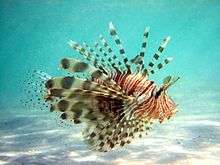
Species
There are currently 12 recognized species in this genus:
| Image | Scientific Name | Common Name | Distribution |
|---|---|---|---|
| Pterois andover G. R. Allen & Erdmann, 2008 | Andover lionfish | Indonesia and Papua New Guinea and ranges as far as Sabah, Malaysia, and the Philippines | |
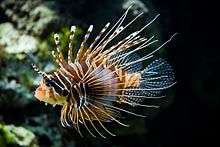 | Pterois antennata (Bloch, 1787) | Spot-fin lionfish | tropical Indian and Western Pacific Oceans |
| Pterois brevipectoralis (Mandritsa, 2002) | Western Indian Ocean | ||
| Pterois cincta Rüppell, 1838 | Red Sea lionfish[5] | Jeddah, Saudi Arabia, Red Sea. | |
 | Pterois lunulata Temminck & Schlegel, 1843 | Luna lionfish | western Pacific Ocean. |
| Pterois miles (J. W. Bennett, 1828) | Devil firefish | Indian Ocean, from the Red Sea, to South Africa, and to Indonesia | |
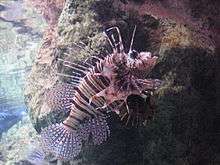 | Pterois mombasae (J. L. B. Smith, 1957) | African lionfish, frill-fin turkeyfish | tropical Indian Ocean and the Western Pacific |
| Pterois paucispinula Matsunuma & Motomura, 2014[6] | India to northern Australia (Timor Sea); north to southern Japan; eastwards to Wallis and Futuna Islands | ||
| Pterois radiata G. Cuvier, 1829 | Clear-fin lionfish[5] | Red Sea to Sodwana Bay, South Africa and to the Society Islands, north to the Ryukyu Islands, south to New Caledonia. | |
 | Pterois russelii E. T. Bennett, 1831 | Plaintail turkeyfish, soldier lionfish, or Russell's lionfish | Persian Gulf and East Africa to New Guinea, south to Western Australia. |
| Pterois sphex D. S. Jordan & Evermann, 1903 | Hawaiian turkeyfish | Hawaii. | |
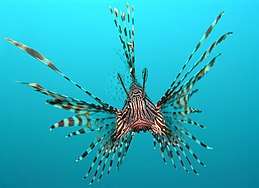 | Pterois volitans (Linnaeus, 1758) | Red lionfish | Indo-Pacific region |
Description
Pterois are harmful to humans. [7][8] Juvenile lionfish have a unique tentacle located above their eye sockets that varies in phenotype between species.[9] The evolution of this tentacle is suggested to serve to continually attract new prey; studies also suggest it plays a role in sexual selection.[9]
Ecology and behavior
Pterois species can live from 5 to 15 years and have complex courtship and mating behaviors.[10] Females release two mucus-filled egg clusters frequently, which can contain as many as 15,000 eggs.[10][11] Studies on Pterois reproductive habits have increased significantly in the past decade.[11] All the species are aposematic: they have conspicuous coloration with boldly contrasting stripes and wide fans of projecting spines, advertising their ability to defend themselves.[12]
Prey
According to a study that involved the dissection of over 1,400 lionfish stomachs from Bahamian to North Carolinian waters, Pterois fish prey mostly on small fish, invertebrates, and mollusks in large amounts, with some specimens’ stomachs containing up to six different species of prey.[13] The amount of prey in lionfish stomachs over the course of a day suggests lionfish feed most actively from 7:00–11:00 a.m., and decrease feeding throughout the afternoon. Lionfish are skilled hunters, using specialized bilateral swim bladder muscles to provide precise control of location in the water column, allowing the fish to alter its center of gravity to better attack prey.[13] The lionfish then spreads its large pectoral fins and swallows its prey in a single motion.[10] They blow jets of water while approaching prey, apparently to disorient them.[14] In addition to confusing prey, these jets of water also alter the orientation of the prey so that the smaller fish is facing the lionfish. This results in a higher degree of predatory efficiency as head-first capture is easier for the lionfish.[15] (In general, when smaller fishes escape from possible danger, they do so against the current.)
Predators and parasites
Aside from instances of larger lionfish individuals engaging in cannibalism on smaller individuals, adult lionfish have few identified natural predators, likely from the effectiveness of their venomous spines. Moray eels (family Muraenidae),[16][17] bluespotted cornetfish (Fistularia commersonii), and large groupers, like the tiger grouper (Mycteroperca tigris)[18] and Nassau grouper (Epinephelus striatus), have been observed preying on lionfish.[19][20][21] It remains unknown, however, how commonly these predators prey on lionfish.[22] Sharks are also believed to be capable of preying on lionfish with no ill effects from their spines.[23] Park officials of the Roatan Marine Park in Honduras have attempted to train sharks to feed on lionfish as of 2011 in an attempt to control the invasive populations in the Caribbean.[24][25] The Bobbit worm, an ambush predator, has been filmed preying upon lionfish in Indonesia.[26] Predators of larvae and juvenile lionfish remain unknown, but may prove to be the primary limiting factor of lionfish populations in their native range.[17]
Parasites of lionfish have rarely been observed and are assumed to be infrequent. They include isopods and leeches.[27]
Interaction with humans
Lionfish are known for their venomous fin rays, an uncommon feature among reef-dwelling fish along the American East Coast and Caribbean. The potency of their venom makes them excellent predators and hazardous to fishermen and divers.[2] Pterois venom produced negative inotropic and chronotropic effects when tested in both frog and clam hearts[28] and has a depressive effect on rabbit blood pressure.[29] These results are thought to be due to nitric oxide release.[8] In humans, Pterois venom can cause systemic effects such as extreme pain, nausea, vomiting, fever, breathing difficulties, convulsions, dizziness, redness on the affected area, headache, numbness, paresthesia (pins and needles), heartburn, diarrhea, and sweating. Rarely, such stings can cause temporary paralysis of the limbs, heart failure, and even death. Fatalities are common in very young children, the elderly, those with a weak immune system, or those who are allergic to their venom. Their venom is rarely fatal to healthy adults, but some species have enough venom to produce extreme discomfort for a period of several days. However, Pterois venom poses a danger to allergic victims as they may experience anaphylaxis, a serious and often life-threatening condition that requires immediate emergency medical treatment. Severe allergic reactions to Pterois venom include chest pain, severe breathing difficulties, a drop in blood pressure, swelling of the tongue, sweating, runny nose, or slurred speech. Such reactions can be fatal if not treated.
Lionfish are edible if prepared correctly.[30]
Native range and habitat
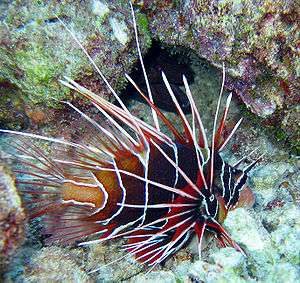
The lionfish is a predator native to the Indo-Pacific. It aggressively preys on small fish and invertebrates. They can be found around the seaward edge of reefs and coral, in lagoons, and on rocky surfaces commonly to 50 m deep, although lionfish have on multiple occasions been recorded to 300 m depth.[31] They show a preference for turbid inshore areas and harbors,[32] and have a generally hostile attitude and are territorial towards other reef fish.[33] Many universities in the Indo-Pacific have documented reports of Pterois aggression towards divers and researchers.[33] P. volitans and P. miles are native to subtropical and tropical regions from southern Japan and southern Korea to the east coast of Australia, Indonesia, Micronesia, French Polynesia, and the South Pacific Ocean.[32] P. miles is also found in the Indian Ocean, from Sumatra to Sri Lanka and the Red Sea.[34]
Invasive introduction and range
Western tropical Atlantic
Two of the twelve species of Pterois, the red lionfish (P. volitans) and the common lionfish (P. miles), have established themselves as significant invasive species off the East Coast of the United States and in the Caribbean. About 93% of the invasive population in the Western Atlantic is P. volitans.[35] They have been described as "one of the most aggressively invasive species on the planet".[25]
The red lionfish is found off the East Coast and Gulf Coast of the United States and in the Caribbean Sea, and was likely first introduced off the Florida coast by the early to mid-1990s.[36] This introduction may have occurred in 1992 when Hurricane Andrew destroyed an aquarium in southern Florida, releasing six lionfish into Biscayne Bay.[37] However, a lionfish was discovered off the coast of Dania Beach, south Florida, as early as 1985, before Hurricane Andrew.[13][38][39] The lionfish resemble those of the Philippines, implicating the aquarium trade.[40] The lionfish may have been purposely discarded by unsatisfied aquarium enthusiasts.[40] This is in part because lionfish require an experienced aquarist, but are often sold to novices who find their care too difficult. In 2001, NOAA documented several sightings of lionfish off the coast of Florida, Georgia, South Carolina, North Carolina, Bermuda, and Delaware. In August 2014, when the Gulf Stream was discharging into the mouth of the Delaware Bay, two lionfish were caught by a surf fisherman off the ocean side shore of Cape Henlopen State Park: a red lionfish that weighed 1 pound 4.5 ounces and a common lionfish that weighed 1 pound 2 ounces. Three days later a 1-pound 3 ounce red lionfish was caught off the shore of Broadkill Beach which is in the Delaware Bay approximately 15 miles north of Cape Henlopen State Park. Lionfish were first detected in the Bahamas in 2004.[41] In June 2013 lionfish were discovered as far east as Barbados,[42] and as far south as the Los Roques Archipelago and many Venezuelan continental beaches.[43] Lionfish were first sighted in Brazilian waters in late 2014. Genetic testing on a single captured individual revealed that it was related to the populations found in the Caribbean, suggesting larval dispersal rather than an intentional release.

Adult lionfish specimens are now found along the United States East Coast from Cape Hatteras, North Carolina, to Florida, and along the Gulf Coast to Texas.[44] They are also found off Bermuda, the Bahamas, and throughout the Caribbean, including the Turks and Caicos, Haiti, Cuba, the Dominican Republic, the Cayman Islands, Aruba, Curacao, Trinidad and Tobago, Bonaire, Puerto Rico, St. Croix, Belize, Honduras,Colombia and Mexico.[2] Population densities continue to increase in the invaded areas, resulting in a population boom of up to 700% in some areas between 2004 and 2008.[2][45]
Lionfish have also established themselves in parts of the Mediterranean with Pterois miles being found in the waters around Cyprus and Malta.[46]
Pterois species are known for devouring many other aquarium fishes,[40] unusual in that they are among the few fish species to successfully establish populations in open marine systems.[47]
Pelagic larval dispersion is assumed to occur through oceanic currents, including the Gulf Stream and the Caribbean Current. Ballast water can also contribute to the dispersal.[2]
Extreme temperatures present geographical constraints in the distribution of aquatic species,[48] indicating temperature tolerance plays a role in the lionfish's survival, reproduction, and range of distribution.[41] The abrupt differences in water temperatures north and south of Cape Hatteras directly correlate with the abundance and distribution of Pterois.[48] Pterois expanded along the southeastern coast of the United States and occupied thermal-appropriate zones within 10 years,[48] and the shoreward expansion of this thermally appropriate habitat is expected in coming decades as winter water temperatures warm in response to anthropogenic climate change.[49] Although the timeline of observations points to the east coast of Florida as the initial source of the western Atlantic invasion, the relationship of the United States East Coast and Bahamian lionfish invasion is uncertain.[50] Lionfish can tolerate a minimum salinity of 5 parts per thousand and even withstand pulses of fresh water, which means they can also be found in estuaries of freshwater rivers.[51]
The lionfish invasion is considered to be one of the most serious recent threats to Caribbean and Florida coral reef ecosystems. To help address the pervasive problem, in 2015 National Oceanic and Atmospheric Administration (NOAA) partnered with the Gulf and Caribbean Fisheries Institute to set up a lionfish portal to provide scientifically accurate information on the invasion and its impacts.[52] The lionfish web portal[53] is aimed at all those involved and affected, including coastal managers, educators and the public and the portal was designed as a source of training videos, fact sheets, examples of management plans, and guidelines for monitoring. The web portal draws on the expertise of NOAA's own scientists as well as that of other scientists and policy makers from academia NGO and managers.
Mediterranean
There is news about lionfish in the sea around Cyprus, Greece and Israel, where warming sea temperatures may be allowing them to expand their range.[54][55]
Long-term effects of invasion
Lionfish have successfully pioneered the coastal waters of the Atlantic in less than a decade and pose a major threat to reef ecological systems in these areas. A study comparing their abundance from Florida to North Carolina with several species of groupers found they were second only to the native scamp grouper and equally abundant to the graysby, gag, and rock hind.[2] This could be due to a surplus of resource availability resulting from the overfishing of lionfish predators like grouper.[56] Although the lionfish has not expanded to a population size currently causing major ecological problems, their invasion in the United States coastal waters could lead to serious problems in the future. One likely ecological impact caused by Pterois could be their impact on prey population numbers by directly affecting food web relationships. This could ultimately lead to reef deterioration and could negatively influence Atlantic trophic cascade.[10] Lionfish have already been shown to overpopulate reef areas and display aggressive tendencies, forcing native species to move to waters where conditions might be less than desirable.[2]
Lionfish could be reducing Atlantic reef diversity by up to 80%.[33] In July 2011, lionfish were reported for the first time in the Flower Garden Banks National Marine Sanctuary off the coast of Louisiana.[57] Sanctuary officials said they believe the species will be a permanent fixture, but hope to monitor and possibly limit their presence.
Since lionfish thrive so well in the Atlantic and the Caribbean due to nutrient-rich waters and lack of predators, the species has spread tremendously. A single lionfish, located on a reef, reduced young juvenile reef fish populations by 79%.[58]
Control and eradication efforts
Red lionfish are an invasive species, yet relatively little is known about them. NOAA has research foci include investigating biotechnical solutions for control of the population, and understanding how the larvae are dispersed. Another important area of study is what controls the population in its native area. Researchers hope to discover what moderates lionfish populations in the Indo-Pacific and apply this information to control the invasive populations, without introducing additional invasive species.
There are two new trap designs that have been introduced to help with deep water control of the lionfish. The traps are low and vertical and remain open the entire time of deployment. The vertical relief of the trap attracts lionfish which makes it easier to catch them. These new traps are good for catching lionfish without affecting the native species that are ecologically, recreationally, and commercially important to the surrounding areas. These traps are more beneficial than older traps because they limit the potential of catching non-invasive creatures, they have bait that is only appealing to lionfish, they guarantee a catch, and they are easy to transport. [59]
Rigorous and repeated removal of lionfish from invaded waters could potentially control the exponential expansion of the lionfish in invaded waters.[2] A 2010 study showed effective maintenance would require the monthly harvest of at least 27% of the adult population. Because lionfish are able to reproduce monthly, this effort must be maintained throughout the entire year.[60]
Even to accomplish these numbers seems unlikely, but as populations of lionfish continue to grow throughout the Caribbean and Western Atlantic, actions are being taken to attempt to control the quickly growing numbers. In November 2010, for the first time the Florida Keys National Marine Sanctuary began licensing divers to kill lionfish inside the sanctuary in an attempt to eradicate the fish.
Conservation groups and community organizations in the Eastern United States have organized hunting expeditions for Pterois such as the Environment Education Foundation's ‘lionfish derby’ held annually in Florida.[45] Divemasters from Cozumel to the Honduran Bay Islands and at Reef Conservation International which operates in the Sapodilla Cayes Marine Reserve off Punta Gorda, Belize, now routinely spear them during dives. However, while diver culling removes lionfish from shallow reefs reducing their densities,[61] lionfish have widely been reported on mesophotic coral ecosystems (reefs from 30–150 m) in the western Atlantic[62] and even in deep-sea habitats (greater than 200 m depth).[31] Recent studies have suggested that the effects of culling are likely to be depth-specific, and so have limited impacts on these deeper reef populations.[63] Therefore, other approaches such as trapping are advocated for removing lionfish from deeper reef habitats.[31][62][63]
Long-term culling has also been recorded to cause behavior changes in lionfish populations. For example, in the Bahamas, lionfish on heavily culled reefs have become more wary of divers and hide more within the reef structure during the day when culling occurs.[64] Similar lionfish responses to divers have been observed when comparing culled sites and sites without culling in Honduras, including altered lionfish behaviour on reefs too deep for regular culling, but adjacent to heavily culled sites potentially implying movement of individuals between depths.[63]
While culling by marine protection agencies and volunteer divers is an important element of control efforts, development of market-based approaches, which create commercial incentives for removals, has been seen as a means to sustain control efforts. The foremost of these market approaches is the promotion of lionfish as a food item.[65][66] Another is the use of lionfish spines, fins and tails for jewelry and other decorative items. Lionfish jewelry production initiatives are underway in Belize, the Bahamas and St. Vincent and the Grenadines.
In 2014 at Jardines de la Reina National Marine Park in Cuba, a diver experimented with spearing and feeding lionfish to sharks in an effort to teach them to seek out the fish as prey.[67] However, by 2016, Cuba was finding it more effective to fish for lionfish as food.[68]
"Lionfish as Food" campaign
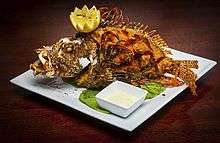
In 2010, NOAA (which also encourages people to report lionfish sightings, to help track lionfish population dispersal)[69] began a campaign to encourage the consumption of the fish.[45] The "Lionfish as Food" campaign encourages human hunting of the fish as the only form of control known to date. Increasing the catch of lionfish could not only help maintain a reasonable population density but also provide an alternative fishing source to overfished populations, such as grouper and snapper. The taste is described as "buttery and tender".[70][71] To promote the campaign, the Roman Catholic Church in Colombia agreed to have their clergy's sermons suggest to their parishioners (84% of the population) eating lionfish on Fridays, Lent and Easter, which proved highly successful in decreasing the invasive fish problem.[72]
When properly filleted, the naturally venomous fish is safe to eat. There has been some concern about the risk of ciguatera food poisoning (CFP) from consumption of lionfish, and the FDA included lionfish on the list of species at risk for CFP when lionfish are harvested in some areas tested positive for ciguatera. However, there have been no verified cases of CFP from consumption of lionfish, and published research has found that the toxins in lionfish venom may be causing false positives in tests for presence of ciguatera.[73] The Reef Environmental Education Foundation provides advice to restaurant chefs on how they can incorporate the fish into their menus. The NOAA calls the lionfish a "delicious, delicately flavored fish" similar in texture to grouper.[45] Cooking techniques and preparations for lionfish include deep-frying, ceviche, jerky, grilling, and sashimi.
See also
References
| Wikimedia Commons has media related to Pterois. |
- National Geographic (11 April 2010). "Lionfish".
- Whitfield P.E., Hare J.A., David A.W., Harter S.L., Muñoz R.C., Addison C.M. (2007). "Abundance estimates of the Indo-Pacific lionfish Pterois volitans/miles complex in the Western North Atlantic". Biological Invasions. 9 (1): 53–64. doi:10.1007/s10530-006-9005-9.CS1 maint: multiple names: authors list (link)
- Plymouth University - Lionfish invading the Mediterranean Sea.
- "Invasive Lionfish Arrive in the Mediterranean". Scientific American. 28 June 2016.
- Matsunuma M., Motomura H. (2015). "Redescriptions of Pterois radiata and Pterois cincta (Scorpaenidae: Pteroinae) with notes on geographic morphological variations in P. radiata". Ichthyological Research. 63 (1): 145–172. doi:10.1007/s10228-015-0483-6.
- Matsunuma, M. & Motomura, H. (2014): Pterois paucispinula, a new species of lionfish (Scorpaenidae: Pteroinae) from the western Pacific Ocean. Ichthyological Research 62(3):327-346.
- Morris Jr., James.A.; Freshwater, D. Wilson (2008). "Phenotypic variation of lionfish supraocular tentacles". Environmental Biology of Fishes. 83 (2): 237–241. doi:10.1007/s10641-007-9326-2.
- Church J.E., Hodgson W.C. (2002). "Adrenergic and cholinergic activity contributes to the cardiovascular effects of lionfish (Pterois volitans) venom". Toxicon. 40 (6): 787–796. doi:10.1016/s0041-0101(01)00285-9. PMID 12175616.
- Morris J.A.Jr., Freshwater D.W. (2007). "Phenotypic variation of lionfish supraocular tentacles". Environmental Biology of Fishes. 83 (2): 237–241. doi:10.1007/s10641-007-9326-2.
- Ruiz-Carus R., Matheson R.Jr., Roberts D.Jr., Whitfield P. (2006). "The western Pacific red lionfish, Pterois volitans (Scorpaenidae), in Florida: Evidence for reproduction and parasitism in the first exotic marine fish established in state waters". Biological Conservation. 128 (3): 384–390. doi:10.1016/j.biocon.2005.10.012.CS1 maint: multiple names: authors list (link)
- Fishelson L (1997). "Experiments and observations on food consumption, growth and starvation in Dendrochirus brachypterus and Pterois volitans (Pteroinae, Scorpaenidae)". Environmental Biology of Fishes. 50 (4): 391–403. doi:10.1023/a:1007331304122.
- Karleskint, G., Turner, R.L. & Small, J.W. (2009). Introduction to Marine Biology. Cengage Learning. p. 276. ISBN 978-0495561972.CS1 maint: multiple names: authors list (link)
- Morris J.A.Jr., Akins J.L. (2009). "Feeding ecology of invasive lionfish (Pterois volitans) in the Bahamian archipelago". Environmental Biology of Fishes. 86 (3): 389–398. CiteSeerX 10.1.1.541.5480. doi:10.1007/s10641-009-9538-8.
- Lee, Jane J. (2012). "Video: Huffing and Puffing For Dinner". ScienceNOW.
- Albins, Mark A.; Lyons, Patrick J. (2012). "Invasive red lionfish Pterois volitans blow directed jets of water at prey fish". Marine Ecology Progress Series. 448: 1–5. doi:10.3354/meps09580.
- Bos A.R., Sanad A.M., Elsayed K. (2017). "Gymnothorax spp. (Muraenidae) as natural predators of the lionfish Pterois miles in its native biogeographical range". Environmental Biology of Fishes. 100 (6): 745–748. doi:10.1007/s10641-017-0600-7.CS1 maint: multiple names: authors list (link)
- Donaldson, T.J., Benavente, D. & Diaz, R. (2010). "Why are lionfishes (Pterois, Scorpaenidae) so rare in their native ranges?" (PDF). Proceedings of the 63rd Gulf and Caribbean Fisheries Institute. 1–5: 352–359.CS1 maint: multiple names: authors list (link)
- Maljković A., Van Leeuwen T.E., Cove S.N. (2008). "Predation on the invasive red lionfish, Pterois volitans (Pisces: Scorpaenidae), by native groupers in the Bahamas". Coral Reefs. 27 (3): 501. doi:10.1007/s00338-008-0372-9.CS1 maint: multiple names: authors list (link)
- Albins, M.A. & Hixon, M.A. (2008). "Invasive Indo-Pacific lionfish Pterois volitans reduce recruitment of Atlantic coral-reef fishes" (PDF). Marine Ecology Progress Series. 367: 233–238. doi:10.3354/meps07620. Archived from the original (PDF) on 26 April 2012.
- Leung, M. (2009). "SW11 Can Blue Cornetfish be used as Biocontrol?".
- Hood, B. (2015). "Lionfish stalked and devoured by grouper in shocking video".
- Morris, J.A.Jr. & Whitfield, P.E. (2009): "Biology, Ecology, Control and Management of the Invasive Indo-Pacific Lionfish: An Updated Integrated Assessment". NOAA Technical Memorandum NOS NCCOS 99. 57 pp.
- Smith, N.S. & Sealey, K.S. (2007). "The Lionfish Invasion in the Bahamas: What do We Know and What to do About It?" (PDF). Proceedings of the 60th Gulf and Caribbean Fisheries Institute. 5–9: 419–423. Archived from the original (PDF) on 25 April 2012.
- Handwerk, B. (2011). "Shark's Lionfish Lunch".
- "Venomous Lionfish". Species of Mass Destruction. Season 1. Episode 2. 2013. The Science Channel.
- "Who Named the Bobbit Worm (Eunice sp.)? And WHAT species is it.. truly??". 13 August 2014.
- Poole, T. (2011). "The sensitivity of the invasive lionfish, Pterois volitans, to parasitism in Bonaire, Dutch Caribbean" (PDF). Physis. 9: 44–49. Archived from the original (PDF) on 16 February 2013. Retrieved 31 December 2011.
- Cohen A.S., Olek A.J. (1989). "An extract of lionfish (Pterois volitans) spine tissue contains acetylcholine and a toxin that affects neuromuscular transmission". Toxicon. 27 (12): 1367–1376. doi:10.1016/0041-0101(89)90068-8. PMID 2560846.
- Sauners P.R., Taylor P.B. (1959). "Venom of the lionfish Pterois volitans". American Journal of Physiology. 197 (2): 437–440. doi:10.1152/ajplegacy.1959.197.2.437. PMID 14441961.
- "Eat lionfish? Sure, but beware of the nasty toxins" 2012 NBC News
- Gress, Erika; Andradi-Brown, Dominic A.; Woodall, Lucy; Schofield, Pamela J.; Stanley, Karl; Rogers, Alex D. (17 August 2017). "Lionfish (Pterois spp.) invade the upper-bathyal zone in the western Atlantic". PeerJ. 5: e3683. doi:10.7717/peerj.3683. ISSN 2167-8359. PMC 5563435. PMID 28828275.
- Schultz E.T. (1986). "Pterois volitans and Pterois miles: Two valid species". Copeia. 1986 (3): 686–690. doi:10.2307/1444950. JSTOR 1444950.
- Myers, R.F. (1991): Micronesian Reef Fishes, Second Edition. Coral Graphics, Barrigada, Guam. p. 298.
- Bos A.R., J.R. Grubich, A.M. Sanad (2018). "Growth, site fidelity and grouper interactions of the Red Sea Lionfish, Pterois miles (Scorpaenidae) in its native habitat". Marine Biology. 165 (10): 175. doi:10.1007/s00227-018-3436-6.CS1 maint: multiple names: authors list (link)
- Hamner R.M., Freshwater D.W., Whitfield P.E. (2007). "Mitochondrial cytochrome b analysis reveals two invasive lionfish species with strong founder effects in the western Atlantic". Journal of Fish Biology. 71: 214–222. doi:10.1111/j.1095-8649.2007.01575.x.CS1 maint: multiple names: authors list (link)
- Whitfield, P., Gardner, T., Vives, S.P., Gilligan, M.R., Courtney, W.R.Jr., Ray, G.C. & Hare, J.A. (2003). "The Introduction and Dispersal of the Indo-Pacific Lionfish (Pterois volitans) Along the Atlantic Coast of North America". Proceedings of the American Academy of Underwater Sciences (22nd Annual Scientific Diving Symposium).CS1 maint: multiple names: authors list (link)
- Goddard, J. (2008). "Lionfish devastate Florida's native shoals". The Times. London.
- "Mystery of the Lionfish: Don't Blame Hurricane Andrew". Science. 2010. Archived from the original on 13 January 2012.
- Schofield P.J. (2009). "Geographic extent and chronology of the invasion of non-native lionfish (Pterois volitans and P. miles) in the Western North Atlantic and Caribbean Sea". Aquatic Invasions. 4 (3): 473–479. doi:10.3391/ai.2009.4.3.5.
- Is the Aquarium Trade to Blame?
- Whitfield P.E., Gardner T., Vives S.P., Gilligan M.R., Courtenay W.R.Jr., Ray G.C., Hare J.A. (2002). "Biological invasion of the Indo-Pacific lionfish Pterois volitans along the Atlantic coast of North America". Marine Ecology Progress Series. 235: 289–297. doi:10.3354/meps235289.CS1 maint: multiple names: authors list (link)
- Lionfish found here Archived 8 January 2012 at the Wayback Machine NationNews.
- Lasso-Alcalá, O.M. & Posada, J.M. (2010): Presence of the invasive red lionfish, Pterois volitans (Linnaeus, 1758), on the coast of Venezuela, southeastern Caribbean Sea. Aquatic Invasions, 5 (Suppl. 1): 53-59
- "Invasive Lionfish Causing Problems in Gulf|| TPW magazine|December 2013".
- Williams, N. (2010): Major lionfish hunt launched. Current Biology, 20 (23): R1005–R1006.
- "University Research Discovers New Alien Species In Maltese Waters". Malta Today. 2016.
- Baltz D.M. (1991). "Introduced fishes in marine systems and inland seas". Biological Conservation. 56 (2): 151–177. doi:10.1016/0006-3207(91)90015-2.
- Kimball M.E., Miller J.M., Whitfield P.E., Hare J.A. (2004). "Thermal Tolerance and Potential Distribution of Invasive Lionfish (Pterois volitans/miles Complex) on the East Coast of the United States". Marine Ecology Progress Series. 283: 269–78. doi:10.3354/meps283269.CS1 maint: multiple names: authors list (link)
- Grieve B.D., Curchitser E.N., Rykaczewski R.R. (2016). "Range expansion of the invasive lionfish in the Northwest Atlantic with climate change". Marine Ecology Progress Series. 546: 225–237. doi:10.3354/meps11638.CS1 maint: multiple names: authors list (link)
- Freshwater D.W., Hines A., Parham S., Wilbur A., Sabaoun M., Woodhead J., Akins L., Purdy B., Whitfield P.E., Paris C.B. (2009). "Mitochondrial control region sequence analyses indicate dispersal from the US East Coast as the source of the invasive Indo-Pacific lionfish Pterois volitans in the Bahamas". Marine Biology. 156 (6): 1213–1221. doi:10.1007/s00227-009-1163-8.CS1 maint: multiple names: authors list (link)
- Shammas, B. (2014). "Palm Beach County girl credited for breakthrough in lionfish research". Sun Sentinel.
- "NOAA, Gulf and Caribbean Fisheries Institute launch new lionfish web portal". www.noaanews.noaa.gov.
- "Invasive Lionfish Portal". Invasive Lionfish Portal. Archived from the original on 5 September 2015.
- Weisberger, Mindy (28 June 2016). "Aliens Attack! Invasive Lionfish Arrive in Mediterranean". livescience.com. Retrieved 13 February 2020.
- Youtube video "Daily Scuba News - Cyprus Has A Massive Lionfish Problem", and its viewers' comments section
- Davis M.A., Grime J.P., Thompson K. (2000). "Fluctuating resources in plant communities: a general theory of invasibility". Journal of Ecology. 88 (3): 528–553. doi:10.1046/j.1365-2745.2000.00473.x.CS1 maint: multiple names: authors list (link)
- "Lionfish Invasion Reaches Gulf Marine Sanctuary". 2011. Archived from the original on 28 September 2011.
- Lionfish invasion continuing to expand
- (JB)https://sanctuaries.noaa.gov/science/conservation/lionfish-trap-guide.html
- Morris J.A.Jr., Shertzer K.A., Rice J.A. (2011). "A stage-based matrix population model of invasive lionfish with implications for control". Biological Invasions. 13 (1): 7–12. doi:10.1007/s10530-010-9786-8.CS1 maint: multiple names: authors list (link)
- Frazer, Thomas K.; Jacoby, Charles A.; Edwards, Morgan A.; Barry, Savanna C.; Manfrino, Carrie M. (1 October 2012). "Coping with the Lionfish Invasion: Can Targeted Removals Yield Beneficial Effects?". Reviews in Fisheries Science. 20 (4): 185–191. doi:10.1080/10641262.2012.700655. ISSN 1064-1262.
- Andradi-Brown, Dominic A.; Vermeij, Mark J. A.; Slattery, Marc; Lesser, Michael; Bejarano, Ivonne; Appeldoorn, Richard; Goodbody-Gringley, Gretchen; Chequer, Alex D.; Pitt, Joanna M. (1 March 2017). "Large-scale invasion of western Atlantic mesophotic reefs by lionfish potentially undermines culling-based management". Biological Invasions. 19 (3): 939–954. doi:10.1007/s10530-016-1358-0. ISSN 1387-3547.
- Andradi-Brown, Dominic A.; Grey, Rachel; Hendrix, Alicia; Hitchner, Drew; Hunt, Christina L.; Gress, Erika; Madej, Konrad; Parry, Rachel L.; Régnier-McKellar, Catriona (1 May 2017). "Depth-dependent effects of culling—do mesophotic lionfish populations undermine current management?". Open Science. 4 (5): 170027. doi:10.1098/rsos.170027. ISSN 2054-5703. PMC 5451808. PMID 28573007.
- Côté, Isabelle M.; Darling, Emily S.; Malpica-Cruz, Luis; Smith, Nicola S.; Green, Stephanie J.; Curtis-Quick, Jocelyn; Layman, Craig (4 April 2014). "What Doesn't Kill You Makes You Wary? Effect of Repeated Culling on the Behaviour of an Invasive Predator". PLOS One. 9 (4): e94248. doi:10.1371/journal.pone.0094248. ISSN 1932-6203. PMC 3976393. PMID 24705447.
- "Inventive Colombians turn invasive fish problem into dinnertime delicacy". Fox News Latino. 2015.
- "Eradicating Invasive Species One Sushi Roll at a Time". NYT. 2016.
- Darryl Fears, Divers try spoon feeding lionfish to sharks, a method that could come back to bite them, Washington Post, 19 October 2014. Accessed 25 July 2017.
- Agence Franc Presse,Poisonous tropical lionfish could be spreading through Mediterranean, The Guardian, 21 June 2016. Accessed 25 July 2017.
- National Oceanic and Atmospheric Administration, National Centers for Coastal Ocean Science "Have You Seen Me?"
- "Eating lionfish". Lionfish Information. Archived from the original on 9 October 2016.
- Serwer, Jesse (4 March 2016). "Venomous, invasive lionfish tastes great and is only served at one NYC restaurant". nydailynews.com. Archived from the original on 8 March 2018.
It’s a sweet, white flaky fish with a taste similar to a parrotfish or a snapper,” John says. “It’s super healthy, very delicate and tender, and it’s easy to cook it just about any way you can think of.
- O'Reilly, Terry (16 February 2017). "Small Move, Big Gain". CBC Radio One. Pirate Radio. Retrieved 18 February 2017.
- Invasive lionfish likely safe to eat after all